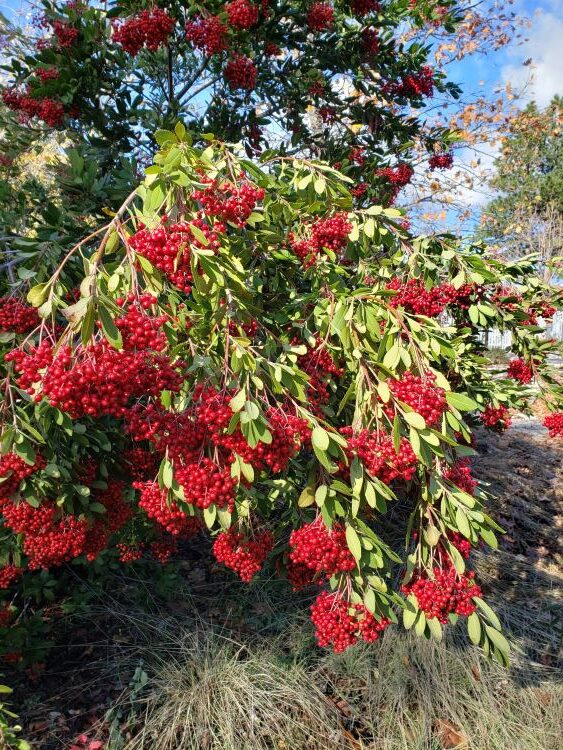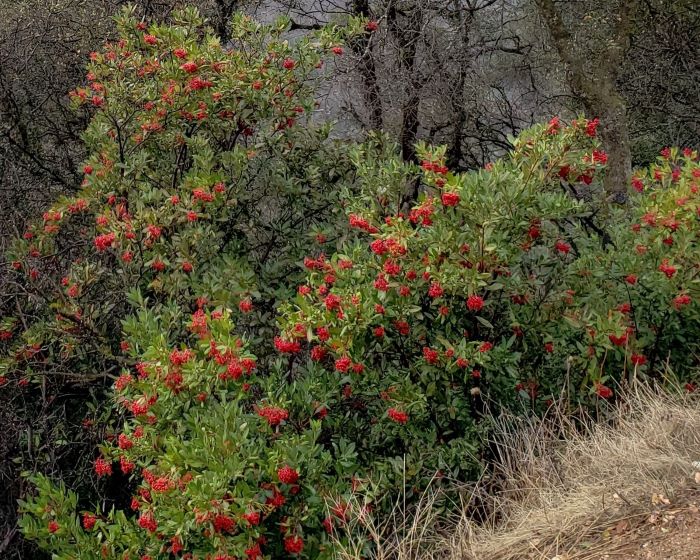“Any plant that encourages bird life, supplies the bees with an unexcelled source of honey, gives food to man, furnishes tannin from its bark, protects arid slopes from erosion, paints the landscape with vivid colors and carries joy into the home at Christmas time, when no other berries are available to most Californians, sure deserves the protection of man, whom it serves so well.”
Ralph Cornell, landscape architect, 1938
These bright red berries are California’s most important winter food source for birds. And from a tough, beautiful, evergreen shrub that’s perfect for landscape use! The shrub is toyon (Heteromeles arbutifolia), a California native living all along the coastal hills and the northern Sierra foothills. It’s also been called Christmas berry or California holly.
The berries ripen from Thanksgiving time to Christmas, providing brilliant red splashes on wild hillsides and along trails.
A client of mine said she always liked toyon. Her mother would bring in boughs with berries for Christmas décor. When I suggested we plant some in her yard she didn’t even know they grew naturally around here. She was happy to get some for her yard. And I want everyone to know what a useful shrub for home landscapes it is.
How does it grow and what does it need?
Toyon likes full sun to part shade. It grows to about 6-10 ft. tall, sometimes to even 20 ft., and 6 ft. or more wide. Reportedly, it can grow to 10 ft. in three years. (There’s an 80 ft. toyon tree with a 6 ft. diameter trunk in Long Beach.)
It prefers faster draining soils but will tolerate heavy clay and serpentine soils. If the soil is heavy, watering must be reduced accordingly.
As a native in the wild it does fine with the water our climate gives it. In a landscape situation it can handle a bit of extra watering, and may even look better. New plants need some water through the first few summers to get them established. After that they can be weaned down to a soaking once a month for summer months only or none at all.
Frequent watering makes it vulnerable to stem and root rot diseases. In fact, frequent shallow watering is the biggest cause of disease and shortened life in natives.
Mulching with a layer of wood chips is a good idea.

Toyon’s flowers and berries are great for wildlife
Toyon flowers have large clusters of tiny white flowers in late June–July, making it a good late source of nectar and pollen for the native bees and butterflies, when most bloom is finished. Its berries feeds the birds in the winter and its foliage feeds the insects that feed the birds, especially in spring. It hosts up to eight native butterfly and moth species who chew on toyon leaves, generating protein for the birds to feed their young.
The red berries ripen from Thanksgiving time to Christmas. They were used for food by the native peoples of California. But use caution. The berries contain a bitter, toxic chemical called cyanogenic glucoside which protects the fruit from being consumed before it’s ripened. Once the fruit is ripened, the chemical gets transferred to the seeds, which passes through animal guts to be dispersed.
Birds know when the fruits are ripe, as did the native peoples, as well as the coyotes and bears. All help to spread the seeds.
Toyon makes the perfect shrub for many landscape situations
- This plant is drought tolerant and deer resistant.
- It can be trimmed to form a hedge and can be used as a screen. Or it can be trimmed to grow as a multi-stemmed tree or as a taller single-trunked tree.
- It’s a perfect shrub to plant under oaks…which should not get watered!
- It’s great on slopes where it helps prevent erosion, and it’s a good highway plant.
- Toyon is a fire-safe plant. Safe enough to be near your home, especially if you give it some occasional deep watering. Just remember to keep it at least 5 ft. away from structures and trimmed well. Out in the larger landscape, if it does burn, it stump-sprouts and regrows very quickly.
- When planting toyon, no amendment or fertilizer is needed. It’s perfectly adapted to our soils and the microorganisms that live there.
- Established plants are virtually maintenance free.
How to find the plants to plant
Check with local nurseries to see if they can get toyon for you.
Sadly, toyon is not usually in the nursery trade, but there are many native plant nurseries that grow toyon. To find them look up Calscape.org (the repository of all information on California native plants) and use the search icon to search for toyon. In every listing there’s the number of “Nurseries That Carry This Plant.” Click on that and you’ll see them all. Our local native nursery is Nevada County Native Plants run by Justin Marciulis. Click on that for information on how to get in touch with him.
Our local Redbud Chapter of the California Native Plant Society has its plant sale on the first Saturday of October each year. These are mostly locally propagated plants. Look up their website to find more information—or better, sign up for news about hikes, presentations, and notices about plant sales.
Now you’ll know what they are when you see them
A couple places to see toyon is along HWY 49 between North San Juan and Nevada City, and from 49 down along Newtown Rd., with its serpentine soils.
I’ve tried to decorate early with the toyon berries, but they blacken too soon to look nice for Christmas. It seems best to harvest right before Christmas. But then, it is the most important winter food source for birds, so go lightly. Or better yet, plant a bunch in your landscape to have enough for you and the birds.
I need some screening, and toyon is my first choice for my in-town landscape in Grass Valley.
Related Reading:
Do Native Plants Pose a Fire Hazard?
The First Thing to Do to Improve the Fire Safety of Your Home
Mulch to Save Water—But What About Flammability?

